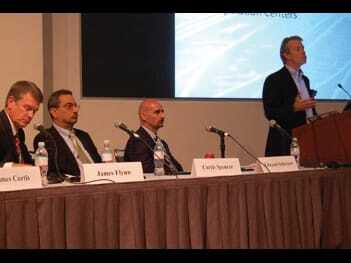A major expansion of the Panama Canal—due to be completed in 2014—may not produce fundamental changes in intermodal shipping and associated U.S. industrial development, a panel at ULI’s 2011 Fall Meeting concluded. While some experts had proclaimed a “game-changer,” the panel of specialists last week reported that a combination of other factors will likely result in only moderate changes as a result of the canal’s expansion, possibly obscured by other, larger economic trends.
Curtis Spencer, president of IMS Worldwide, a supply-chain consultancy, gave an overview of global intermodal supply-chain trends and the forces likely to affect them most. In part because of existing limits to the Panama Canal, many shippers now deliver to the West Coast and then deliver to inland destinations by rail. But the new canal will still only accommodate ships up to 14,500 TEUs (or twenty-foot equivalent units, the basic shipping unit), and many newer ships are even larger than that. Therefore, although the canal will be able to accommodate ships up to three times larger, those ships will only account for at most an additional 35.6 percent of the total shipping volume.
More basic economic limits arise from the logistics of East Coast port sizes and positions. Although major ports such as Miami, Florida, will be able to accommodate very large volumes, the rail capacity and cost to distribute to inland locations will not shift the present economic disadvantage significantly. The major railroads serving the West Coast—Union Pacific and BNSF—will also likely cut prices to stay competitive. As a result, Spencer said he believes the economic “break-even line” between East Coast deliveries through the Panama Canal and West Coast deliveries to Long Beach or other ports will shift only moderately—providing perhaps only an additional 2 percent of market share for goods shipped through the canal.
Jim Flynn, president of the Carson Companies, an industrial real estate developer active in Texas and southern California, pointed to shifts in manufacturing trends and growing improvements in Mexico’s competitiveness as a U.S. exporter relative to China. Unlike China, Mexico has a favorable currency exchange rate, shipping time is short, duties are low, and intellectual property rights are protected. The advantage that China has enjoyed in wages is slowly eroding as well.
Jim Curtis, managing partner of the Bristol Group, an industrial real estate development firm based in San Francisco, also noted that a number of shifting factors drive supply-chain decisions and demand for shipping: labor arbitrage, transport energy costs, manufacturing redundancy, and growth of population centers. Rising Chinese energy and labor costs do point toward a lower volume of imports, and a return to more domestic manufacturing.
In addition, shippers are still using the Suez Canal route, which remains competitive. Despite pirate attacks, shipped tonnage has increased by more than 50 percent in the last decade. Curtis indicated that he believes China will also provide draconian security measures for Chinese ships in the area. “They will take care of pirates—you’ll see them disappear quietly, like the cats in Golden Gate Park,” he said wryly.
Moderator Ed Schreyer, executive managing director of industrial services for CBRE, took questions and moderated a lively discussion. What about Canadian ports such as Vancouver and Prince Rupert Sound? Curtis responded that these are excellent facilities and that the Canadian Railway is exceptionally efficient—but there is no “back-out” of export goods, meaning the economics are not as attractive. Miami has good back-out, but poor rail access to the rest of the country.





